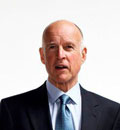Gov. Brown’s Plan
Gov. Brown’s plan is divided into several tiers of renewable energy projects, which include solar, wind, small hydro, geothermal, and biomass. The first tier is to build 12,000 MWs of localized electricity generation. This focuses on onsite energy systems or systems near the area where the electricity is consumed. This cuts down on costs associated with energy transmission lines and environmental impact. Solar systems on roofs of warehouses, parking lot structures, schools, and commercial buildings can typically handle 2 MW solar systems. Larger public and private lands and solar panels alongside highways can typically handle 20 MW systems. Gov. Brown also notes that legislation to limit rates and protect consumers must accompany this part of the plan.
Large Scale Production
The second tier of Gov. Brown’s system is to build 8,000 MW of large-scale renewable energy production and associated transmission lines. He has several legislative solutions to focus on cutting red tape. Notably, he calls for a general plan with one, large environmental review. Gov. Brown has a fast track plan to cut California’s infamous ‘red tape’ beuracratic burden for new clean energy projects, which currently makes the average large scale project a 6 to 8 year ordeal. His plan will reduce that time to less than three years. Also, he plans to push for legislative standards to require a minimum of 33 percent renewable energy for the State of California.
Jobs
Next, Gov. Brown plans to create 8,500 jobs by incentivizing the development of energy storage systems to offset peak energy demands. Also, he has a plan to increase the energy efficiency of buildings and appliances. Gov. Brown’s energy plan will also incentivize cogeneration. Cogeneration is combined heat and power projects, which makes use of excess heat or electricity generated by industrial and power plants.
The healthcare impact may be substantial if Gov. Brown can achieve his goal of 20,000 new megawatts (MW) of renewable electricity by 2020. Reducing air pollution will reduce asthma rates and other diseases and the subsequent impact on the hospital system, nurses, nursing professionals, doctors, acupuncturists, and many other healthcare professionals.


